engine Lancia Musa 2010 Owner handbook (in English)
[x] Cancel search | Manufacturer: LANCIA, Model Year: 2010, Model line: Musa, Model: Lancia Musa 2010Pages: 218, PDF Size: 3.71 MB
Page 84 of 218
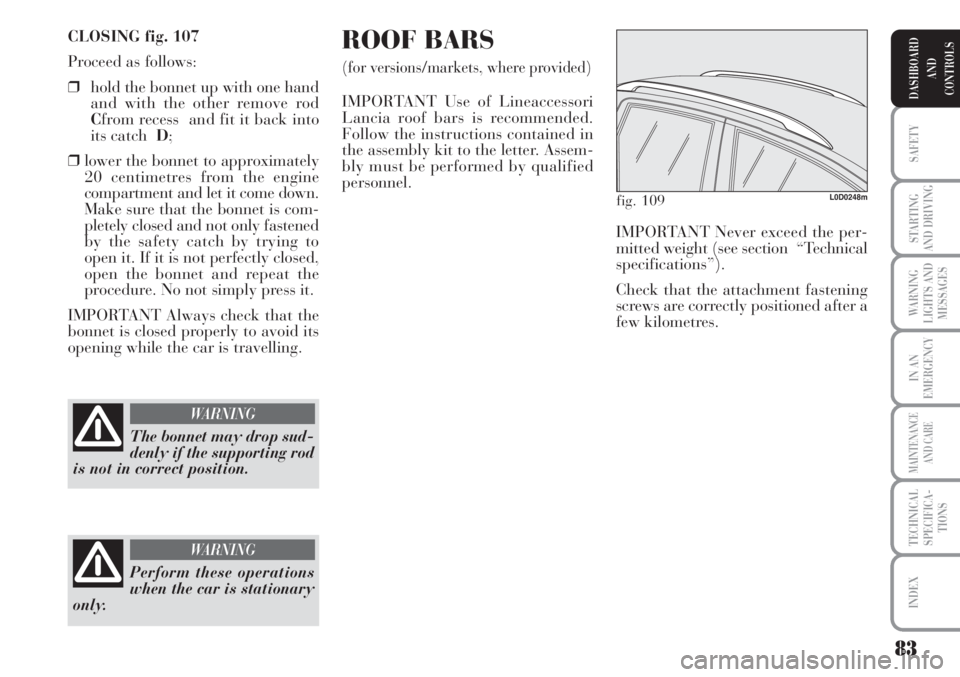
83
SAFETY
STARTING
AND DRIVING
WARNING
LIGHTS AND
MESSAGES
IN AN
EMERGENCY
MAINTENANCE
AND CARE
TECHNICAL
SPECIFICA-
TIONS
INDEX
DASHBOARD
AND
CONTROLS
CLOSING fig. 107
Proceed as follows:
❒hold the bonnet up with one hand
and with the other remove rod
Cfrom recess and fit it back into
its catchD;
❒lower the bonnet to approximately
20 centimetres from the engine
compartment and let it come down.
Make sure that the bonnet is com-
pletely closed and not only fastened
by the safety catch by trying to
open it. If it is not perfectly closed,
open the bonnet and repeat the
procedure. No not simply press it.
IMPORTANT Always check that the
bonnet is closed properly to avoid its
opening while the car is travelling.ROOF BARS
(for versions/markets, where provided)
IMPORTANT Use of Lineaccessori
Lancia roof bars is recommended.
Follow the instructions contained in
the assembly kit to the letter. Assem-
bly must be performed by qualified
personnel.
The bonnet may drop sud-
denly if the supporting rod
is not in correct position.
WARNING
Perform these operations
when the car is stationary
only.
WARNING
fig. 109L0D0248m
IMPORTANT Never exceed the per-
mitted weight (see section “Technical
specifications”).
Check that the attachment fastening
screws are correctly positioned after a
few kilometres.
Page 87 of 218
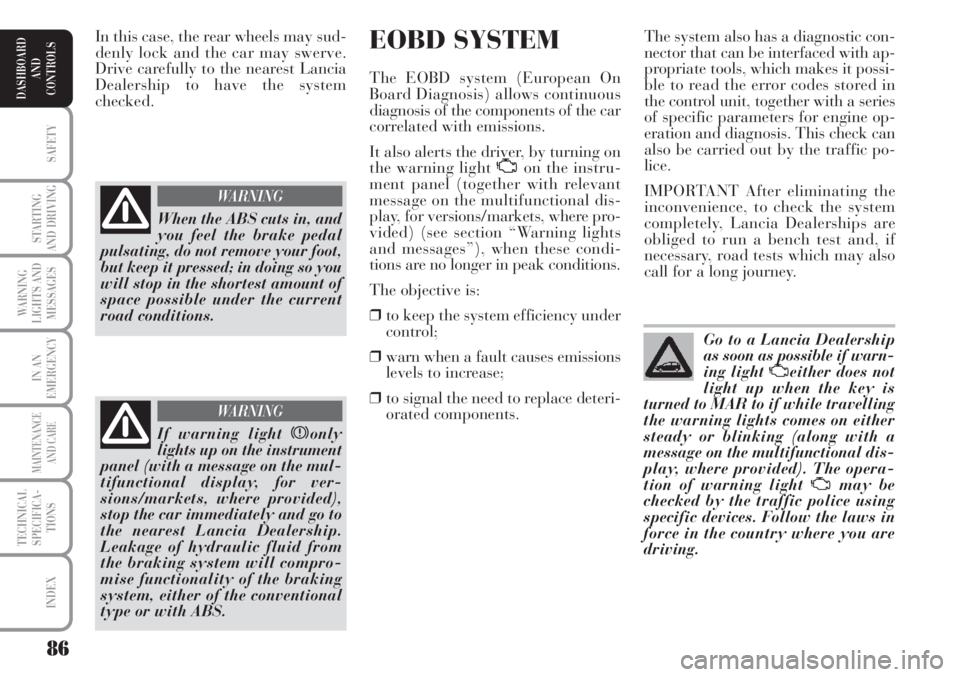
86
SAFETY
STARTING
AND DRIVING
WARNING
LIGHTS AND
MESSAGES
IN AN
EMERGENCY
MAINTENANCE
AND CARE
TECHNICAL
SPECIFICA-
TIONS
INDEX
DASHBOARD
AND
CONTROLS
EOBD SYSTEM
The EOBD system (European On
Board Diagnosis) allows continuous
diagnosis of the components of the car
correlated with emissions.
It also alerts the driver, by turning on
the warning light
Uon the instru-
ment panel (together with relevant
message on the multifunctional dis-
play, for versions/markets, where pro-
vided) (see section “Warning lights
and messages”), when these condi-
tions are no longer in peak conditions.
The objective is:
❒to keep the system efficiency under
control;
❒warn when a fault causes emissions
levels to increase;
❒to signal the need to replace deteri-
orated components. In this case, the rear wheels may sud-
denly lock and the car may swerve.
Drive carefully to the nearest Lancia
Dealership to have the system
checked.The system also has a diagnostic con-
nector that can be interfaced with ap-
propriate tools, which makes it possi-
ble to read the error codes stored in
the control unit, together with a series
of specific parameters for engine op-
eration and diagnosis. This check can
also be carried out by the traffic po-
lice.
IMPORTANT After eliminating the
inconvenience, to check the system
completely, Lancia Dealerships are
obliged to run a bench test and, if
necessary, road tests which may also
call for a long journey.
When the ABS cuts in, and
you feel the brake pedal
pulsating, do not remove your foot,
but keep it pressed; in doing so you
will stop in the shortest amount of
space possible under the current
road conditions.
WARNING
If warning light xonly
lights up on the instrument
panel (with a message on the mul-
tifunctional display, for ver-
sions/markets, where provided),
stop the car immediately and go to
the nearest Lancia Dealership.
Leakage of hydraulic fluid from
the braking system will compro-
mise functionality of the braking
system, either of the conventional
type or with ABS.
WARNING
Go to a Lancia Dealership
as soon as possible if warn-
ing light Ueither does not
light up when the key is
turned to MAR to if while travelling
the warning lights comes on either
steady or blinking (along with a
message on the multifunctional dis-
play, where provided). The opera-
tion of warning light Umay be
checked by the traffic police using
specific devices. Follow the laws in
force in the country where you are
driving.
Page 90 of 218
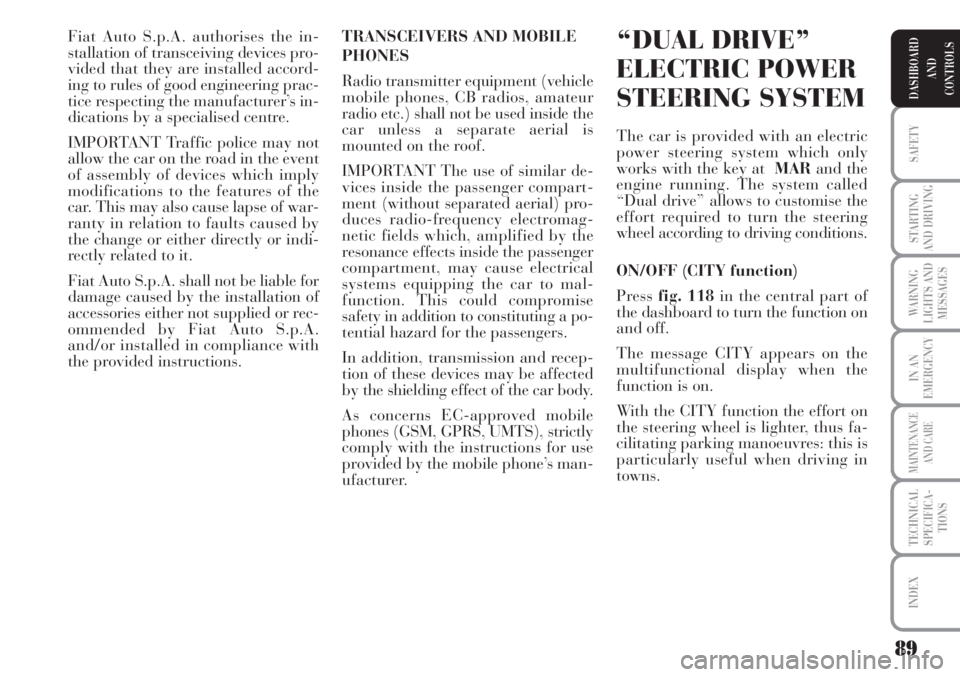
89
SAFETY
STARTING
AND DRIVING
WARNING
LIGHTS AND
MESSAGES
IN AN
EMERGENCY
MAINTENANCE
AND CARE
TECHNICAL
SPECIFICA-
TIONS
INDEX
DASHBOARD
AND
CONTROLS
Fiat Auto S.p.A. authorises the in-
stallation of transceiving devices pro-
vided that they are installed accord-
ing to rules of good engineering prac-
tice respecting the manufacturer’s in-
dications by a specialised centre.
IMPORTANT Traffic police may not
allow the car on the road in the event
of assembly of devices which imply
modifications to the features of the
car. This may also cause lapse of war-
ranty in relation to faults caused by
the change or either directly or indi-
rectly related to it.
Fiat Auto S.p.A. shall not be liable for
damage caused by the installation of
accessories either not supplied or rec-
ommended by Fiat Auto S.p.A.
and/or installed in compliance with
the provided instructions.“DUAL DRIVE”
ELECTRIC POWER
STEERING SYSTEM
The car is provided with an electric
power steering system which only
works with the key at MARand the
engine running. The system called
“Dual drive” allows to customise the
effort required to turn the steering
wheel according to driving conditions.
ON/OFF (CITY function)
Press fig. 118in the central part of
the dashboard to turn the function on
and off.
The message CITY appears on the
multifunctional display when the
function is on.
With the CITY function the effort on
the steering wheel is lighter, thus fa-
cilitating parking manoeuvres: this is
particularly useful when driving in
towns. TRANSCEIVERS AND MOBILE
PHONES
Radio transmitter equipment (vehicle
mobile phones, CB radios, amateur
radio etc.) shall not be used inside the
car unless a separate aerial is
mounted on the roof.
IMPORTANT The use of similar de-
vices inside the passenger compart-
ment (without separated aerial) pro-
duces radio-frequency electromag-
netic fields which, amplified by the
resonance effects inside the passenger
compartment, may cause electrical
systems equipping the car to mal-
function. This could compromise
safety in addition to constituting a po-
tential hazard for the passengers.
In addition, transmission and recep-
tion of these devices may be affected
by the shielding effect of the car body.
As concerns EC-approved mobile
phones (GSM, GPRS, UMTS), strictly
comply with the instructions for use
provided by the mobile phone’s man-
ufacturer.
Page 91 of 218
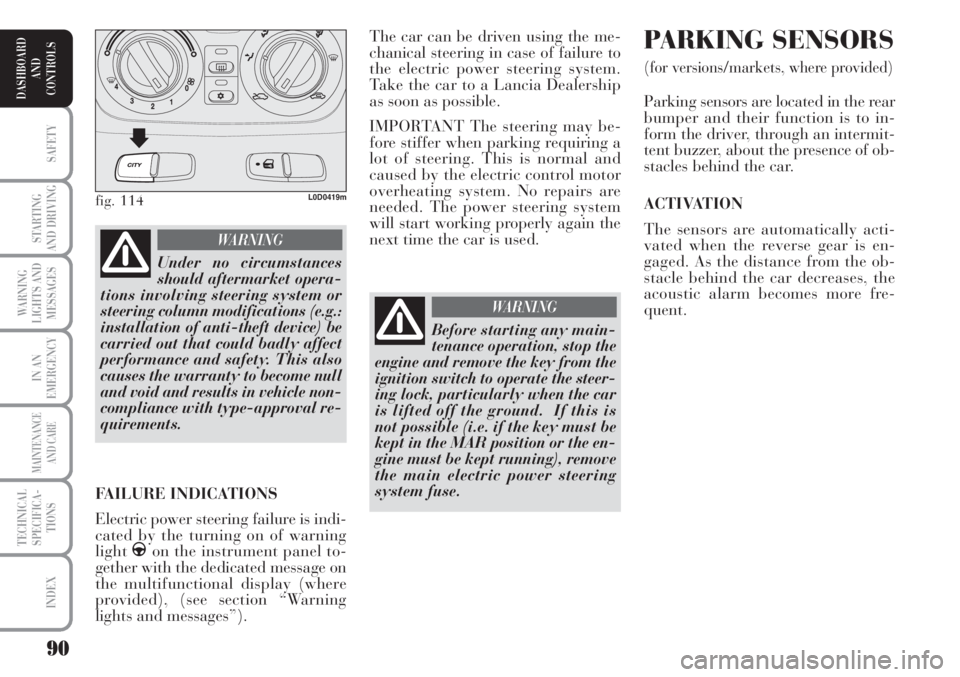
90
SAFETY
STARTING
AND DRIVING
WARNING
LIGHTS AND
MESSAGES
IN AN
EMERGENCY
MAINTENANCE
AND CARE
TECHNICAL
SPECIFICA-
TIONS
INDEX
DASHBOARD
AND
CONTROLS
The car can be driven using the me-
chanical steering in case of failure to
the electric power steering system.
Take the car to a Lancia Dealership
as soon as possible.
IMPORTANT The steering may be-
fore stiffer when parking requiring a
lot of steering. This is normal and
caused by the electric control motor
overheating system. No repairs are
needed. The power steering system
will start working properly again the
next time the car is used. PARKING SENSORS
(for versions/markets, where provided)
Parking sensors are located in the rear
bumper and their function is to in-
form the driver, through an intermit-
tent buzzer, about the presence of ob-
stacles behind the car.
ACTIVATION
The sensors are automatically acti-
vated when the reverse gear is en-
gaged. As the distance from the ob-
stacle behind the car decreases, the
acoustic alarm becomes more fre-
quent.
fig. 114L0D0419m
Under no circumstances
should aftermarket opera-
tions involving steering system or
steering column modifications (e.g.:
installation of anti-theft device) be
carried out that could badly affect
performance and safety. This also
causes the warranty to become null
and void and results in vehicle non-
compliance with type-approval re-
quirements.
WARNING
FAILURE INDICATIONS
Electric power steering failure is indi-
cated by the turning on of warning
light
gon the instrument panel to-
gether with the dedicated message on
the multifunctional display (where
provided), (see section “Warning
lights and messages”).
Before starting any main-
tenance operation, stop the
engine and remove the key from the
ignition switch to operate the steer-
ing lock, particularly when the car
is lifted off the ground. If this is
not possible (i.e. if the key must be
kept in the MAR position or the en-
gine must be kept running), remove
the main electric power steering
system fuse.
WARNING
Page 93 of 218
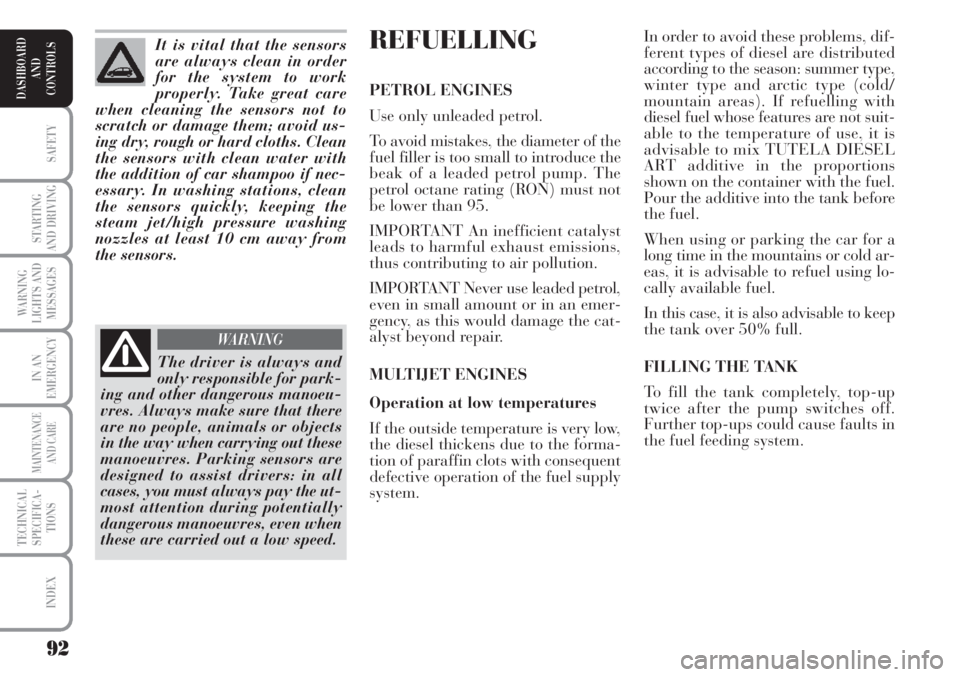
92
SAFETY
STARTING
AND DRIVING
WARNING
LIGHTS AND
MESSAGES
IN AN
EMERGENCY
MAINTENANCE
AND CARE
TECHNICAL
SPECIFICA-
TIONS
INDEX
DASHBOARD
AND
CONTROLS
REFUELLING
PETROL ENGINES
Use only unleaded petrol.
To avoid mistakes, the diameter of the
fuel filler is too small to introduce the
beak of a leaded petrol pump. The
petrol octane rating (RON) must not
be lower than 95.
IMPORTANT An inefficient catalyst
leads to harmful exhaust emissions,
thus contributing to air pollution.
IMPORTANT Never use leaded petrol,
even in small amount or in an emer-
gency, as this would damage the cat-
alyst beyond repair.
MULTIJET ENGINES
Operation at low temperatures
If the outside temperature is very low,
the diesel thickens due to the forma-
tion of paraffin clots with consequent
defective operation of the fuel supply
system.In order to avoid these problems, dif-
ferent types of diesel are distributed
according to the season: summer type,
winter type and arctic type (cold/
mountain areas). If refuelling with
diesel fuel whose features are not suit-
able to the temperature of use, it is
advisable to mix TUTELA DIESEL
ART additive in the proportions
shown on the container with the fuel.
Pour the additive into the tank before
the fuel.
When using or parking the car for a
long time in the mountains or cold ar-
eas, it is advisable to refuel using lo-
cally available fuel.
In this case, it is also advisable to keep
the tank over 50% full.
FILLING THE TANK
To fill the tank completely, top-up
twice after the pump switches off.
Further top-ups could cause faults in
the fuel feeding system. It is vital that the sensors
are always clean in order
for the system to work
properly. Take great care
when cleaning the sensors not to
scratch or damage them; avoid us-
ing dry, rough or hard cloths. Clean
the sensors with clean water with
the addition of car shampoo if nec-
essary. In washing stations, clean
the sensors quickly, keeping the
steam jet/high pressure washing
nozzles at least 10 cm away from
the sensors.
The driver is always and
only responsible for park-
ing and other dangerous manoeu-
vres. Always make sure that there
are no people, animals or objects
in the way when carrying out these
manoeuvres. Parking sensors are
designed to assist drivers: in all
cases, you must always pay the ut-
most attention during potentially
dangerous manoeuvres, even when
these are carried out a low speed.
WARNING
Page 94 of 218
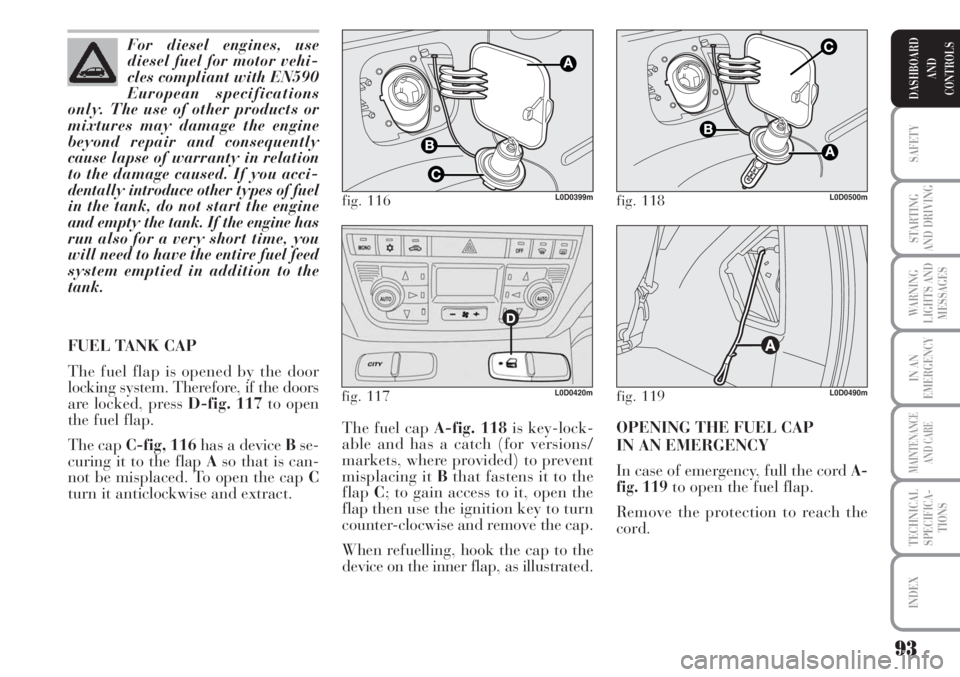
93
SAFETY
STARTING
AND DRIVING
WARNING
LIGHTS AND
MESSAGES
IN AN
EMERGENCY
MAINTENANCE
AND CARE
TECHNICAL
SPECIFICA-
TIONS
INDEX
DASHBOARD
AND
CONTROLS
The fuel cap A-fig. 118is key-lock-
able and has a catch (for versions/
markets, where provided) to prevent
misplacing it Bthat fastens it to the
flapC; to gain access to it, open the
flap then use the ignition key to turn
counter-clocwise and remove the cap.
When refuelling, hook the cap to the
device on the inner flap, as illustrated.OPENING THE FUEL CAP
IN AN EMERGENCY
In case of emergency, full the cord
A-
fig. 119to open the fuel flap.
Remove the protection to reach the
cord. For diesel engines, use
diesel fuel for motor vehi-
cles compliant with EN590
European specifications
only. The use of other products or
mixtures may damage the engine
beyond repair and consequently
cause lapse of warranty in relation
to the damage caused. If you acci-
dentally introduce other types of fuel
in the tank, do not start the engine
and empty the tank. If the engine has
run also for a very short time, you
will need to have the entire fuel feed
system emptied in addition to the
tank.
FUEL TANK CAP
The fuel flap is opened by the door
locking system. Therefore, if the doors
are locked, press D-fig. 117to open
the fuel flap.
The cap C-fig, 116has a device Bse-
curing it to the flap Aso that is can-
not be misplaced. To open the cap C
turn it anticlockwise and extract.
fig. 116L0D0399m
fig. 119L0D0490mfig. 117L0D0420m
fig. 118L0D0500m
Page 95 of 218
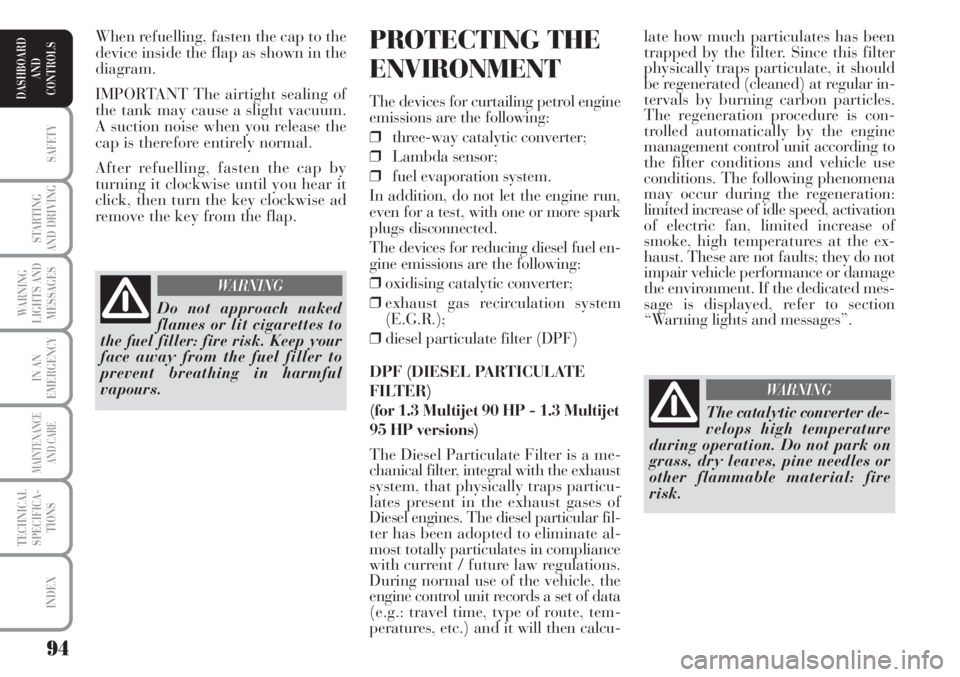
94
SAFETY
STARTING
AND DRIVING
WARNING
LIGHTS AND
MESSAGES
IN AN
EMERGENCY
MAINTENANCE
AND CARE
TECHNICAL
SPECIFICA-
TIONS
INDEX
DASHBOARD
AND
CONTROLS
late how much particulates has been
trapped by the filter. Since this filter
physically traps particulate, it should
be regenerated (cleaned) at regular in-
tervals by burning carbon particles.
The regeneration procedure is con-
trolled automatically by the engine
management control unit according to
the filter conditions and vehicle use
conditions. The following phenomena
may occur during the regeneration:
limited increase of idle speed, activation
of electric fan, limited increase of
smoke, high temperatures at the ex-
haust. These are not faults; they do not
impair vehicle performance or damage
the environment. If the dedicated mes-
sage is displayed, refer to section
“Warning lights and messages”.PROTECTING THE
ENVIRONMENT
The devices for curtailing petrol engine
emissions are the following:
❒three-way catalytic converter;
❒Lambda sensor;
❒fuel evaporation system.
In addition, do not let the engine run,
even for a test, with one or more spark
plugs disconnected.
The devices for reducing diesel fuel en-
gine emissions are the following:
❒oxidising catalytic converter;
❒exhaust gas recirculation system
(E.G.R.);
❒diesel particulate filter (DPF)
DPF (DIESEL PARTICULATE
FILTER)
(for 1.3 Multijet 90 HP - 1.3 Multijet
95 HP versions)
The Diesel Particulate Filter is a me-
chanical filter, integral with the exhaust
system, that physically traps particu-
lates present in the exhaust gases of
Diesel engines. The diesel particular fil-
ter has been adopted to eliminate al-
most totally particulates in compliance
with current / future law regulations.
During normal use of the vehicle, the
engine control unit records a set of data
(e.g.: travel time, type of route, tem-
peratures, etc.) and it will then calcu- When refuelling, fasten the cap to the
device inside the flap as shown in the
diagram.
IMPORTANT The airtight sealing of
the tank may cause a slight vacuum.
A suction noise when you release the
cap is therefore entirely normal.
After refuelling, fasten the cap by
turning it clockwise until you hear it
click, then turn the key clockwise ad
remove the key from the flap.
Do not approach naked
flames or lit cigarettes to
the fuel filler: fire risk. Keep your
face away from the fuel filler to
prevent breathing in harmful
vapours.
WARNING
The catalytic converter de-
velops high temperature
during operation. Do not park on
grass, dry leaves, pine needles or
other flammable material: fire
risk.
WARNING
Page 98 of 218

97
STARTING
AND DRIVING
WARNING
LIGHTS AND
MESSAGES
IN AN
EMERGENCY
MAINTENANCE
AND CARE
TECHNICAL
SPECIFICA-
TIONS
INDEX
DASHBOARD
AND
CONTROLS
SAFETY
S.B.R. system
The car is fitted with a Seat Belt Re-
minder system (S.B.R.), consisting of
a buzzer and a flashing warning light
must be fastened.
The buzzer can be deactivated (until
the next engine stop) as follows:
❒fasten the driver’s seat belt;
❒turn the ignition key to MAR;
❒wait for over 20 seconds and then
release one of the seat belts.
For permanent deactivation, contact
a Lancia Dealership.
The S.B.R. can only be reactivated us-
ing the setup menu (see the “Warning
lights and messages” chapter, “Seat
belt reminder” paragraph).ADJUSTING THE FRONT SEAT
BELT HEIGHT
(for versions/markets, where provided)
Always adjust the seat belt height to
the passenger’s body: this precaution
may considerably reduce the risk of
injury in the event of a collision.
Correct regulation is obtained when
the belt passes approximately half
way between the shoulder and the
neck.
To adjust, move the grip A-fig. 4of
the locking mechanism either up or
down and at the same time move the
ringBto the most suitable of the al-
lowed positions.
Remember that in the
event of a violent collision,
back seat passengers not wearing
seat belts also represent a serious
danger for the front seat passen-
gers.
WARNING
fig. 4L0D0128m
The height of the seat belts
must be adjusted with the
car at a standstill.
WARNING
After adjustment, always
check that the cursor to
which the ring is fastened is locked
in one of the set positions. Release
the grip and push downwards to
enable the locking device to click if
the grip has not been released in
one of the possible positions.
WARNING
Page 113 of 218
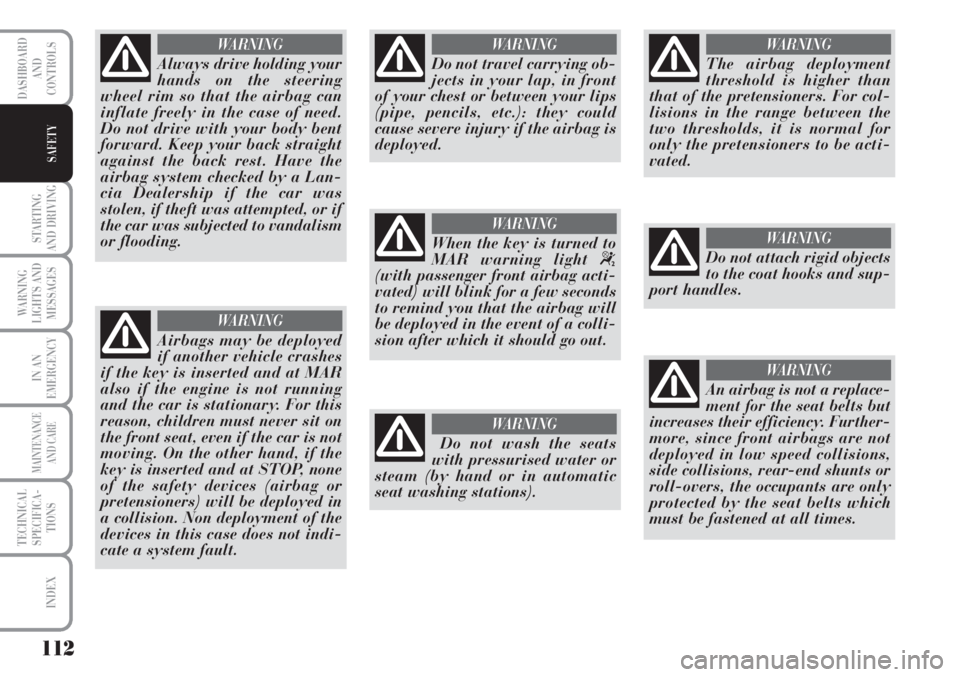
112
STARTING
AND DRIVING
WARNING
LIGHTS AND
MESSAGES
IN AN
EMERGENCY
MAINTENANCE
AND CARE
TECHNICAL
SPECIFICA-
TIONS
INDEX
DASHBOARD
AND
CONTROLS
SAFETY
Always drive holding your
hands on the steering
wheel rim so that the airbag can
inflate freely in the case of need.
Do not drive with your body bent
forward. Keep your back straight
against the back rest. Have the
airbag system checked by a Lan-
cia Dealership if the car was
stolen, if theft was attempted, or if
the car was subjected to vandalism
or flooding.
WARNING
Do not travel carrying ob-
jects in your lap, in front
of your chest or between your lips
(pipe, pencils, etc.): they could
cause severe injury if the airbag is
deployed.
WARNING
The airbag deployment
threshold is higher than
that of the pretensioners. For col-
lisions in the range between the
two thresholds, it is normal for
only the pretensioners to be acti-
vated.
WARNING
When the key is turned to
MAR warning light
“(with passenger front airbag acti-
vated) will blink for a few seconds
to remind you that the airbag will
be deployed in the event of a colli-
sion after which it should go out.
WARNING
Do not wash the seats
with pressurised water or
steam (by hand or in automatic
seat washing stations).
WARNING
An airbag is not a replace-
ment for the seat belts but
increases their efficiency. Further-
more, since front airbags are not
deployed in low speed collisions,
side collisions, rear-end shunts or
roll-overs, the occupants are only
protected by the seat belts which
must be fastened at all times.
WARNING
Do not attach rigid objects
to the coat hooks and sup-
port handles.
WARNING
Airbags may be deployed
if another vehicle crashes
if the key is inserted and at MAR
also if the engine is not running
and the car is stationary. For this
reason, children must never sit on
the front seat, even if the car is not
moving. On the other hand, if the
key is inserted and at STOP, none
of the safety devices (airbag or
pretensioners) will be deployed in
a collision. Non deployment of the
devices in this case does not indi-
cate a system fault.
WARNING
Page 114 of 218
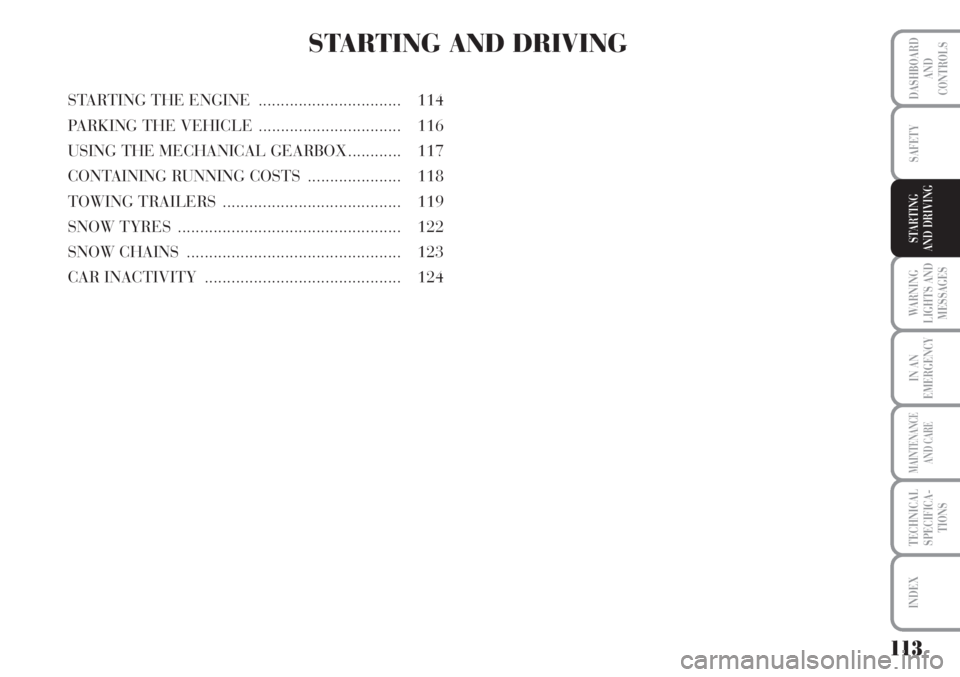
113
WARNING
LIGHTS AND
MESSAGES
IN AN
EMERGENCY
MAINTENANCE
AND CARE
TECHNICAL
SPECIFICA-
TIONS
INDEX
DASHBOARD
AND
CONTROLS
SAFETY
STARTING
AND DRIVING
STARTING AND DRIVING
STARTING THE ENGINE................................ 114
PARKING THE VEHICLE ................................ 116
USING THE MECHANICAL GEARBOX............ 117
CONTAINING RUNNING COSTS ..................... 118
TOWING TRAILERS ........................................ 119
SNOW TYRES .................................................. 122
SNOW CHAINS ................................................ 123
CAR INACTIVITY ............................................ 124